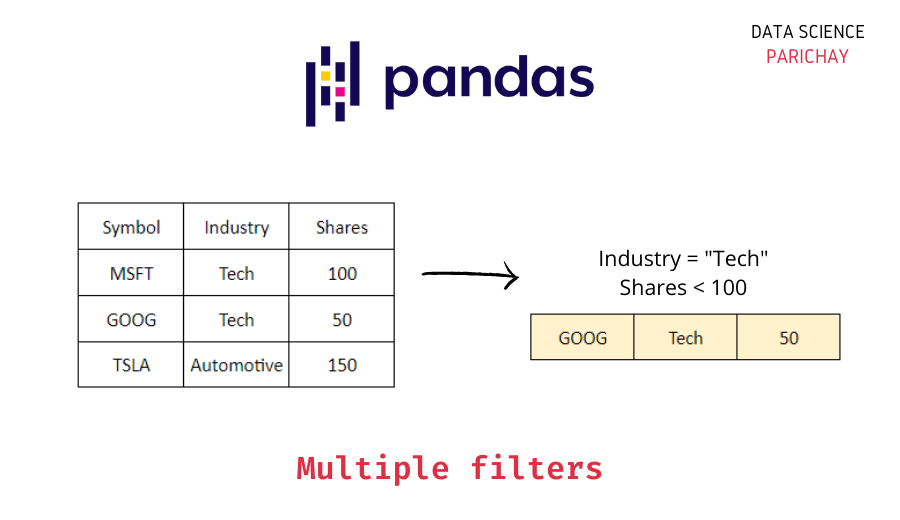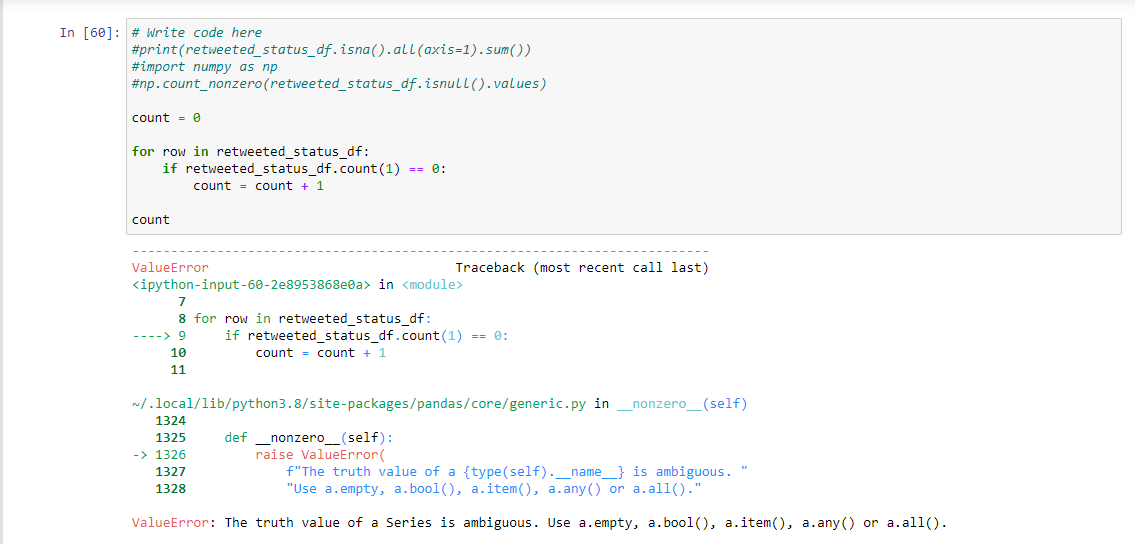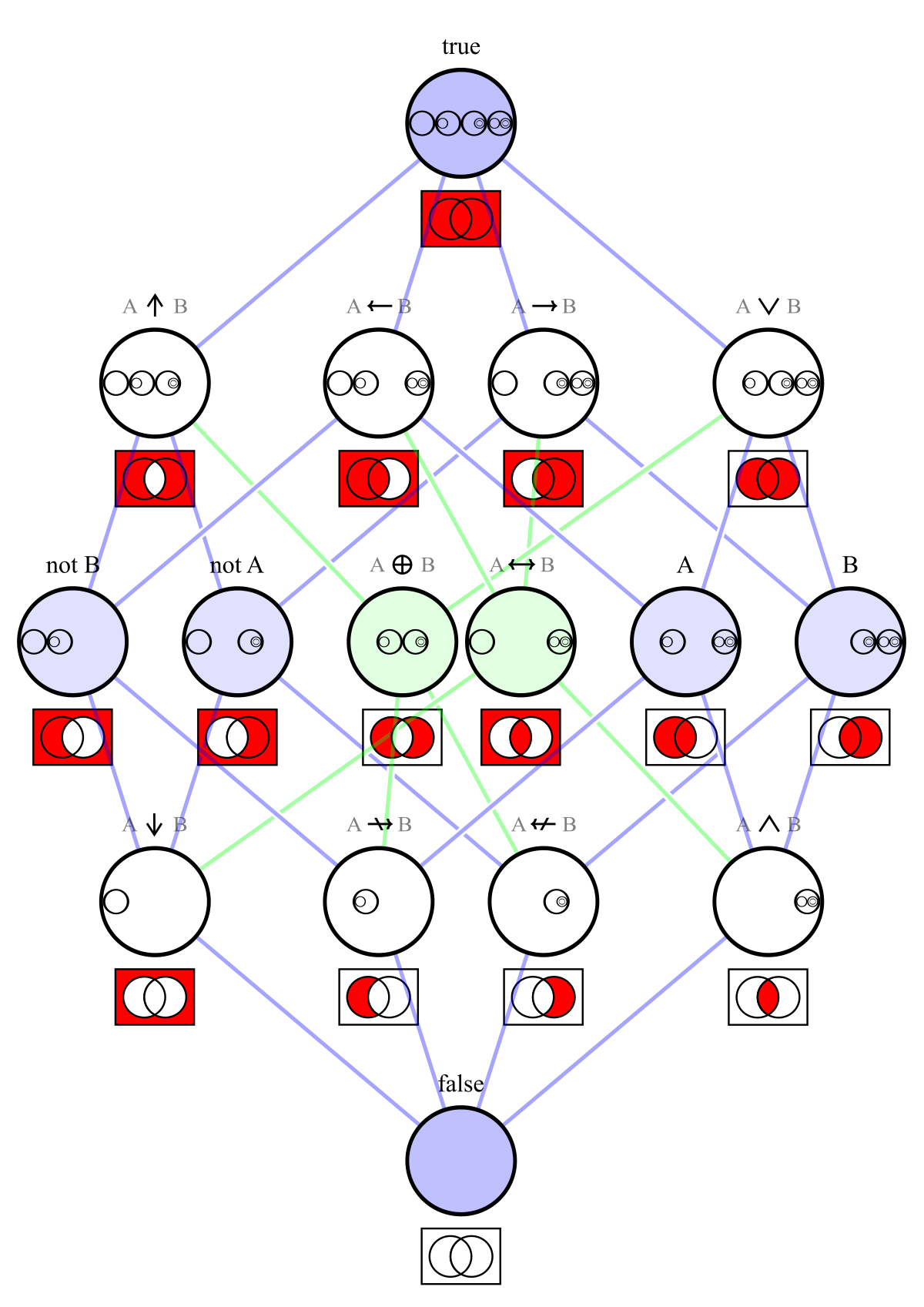The Truth Value Of A Series Is Ambiguous
Understanding Truth Value
The concept of truth value is fundamental in logic and reasoning. It refers to the truthfulness or falsehood of a statement. In English, truth value is generally assigned to individual statements, which can be classified as either true or false. However, when dealing with a series or a collection of statements, the truth value can become ambiguous.
Different Perspectives on Truth Value
Various perspectives exist when it comes to evaluating truth value in a series. One perspective suggests that if any statement within the series is false, the entire series should be considered false. This viewpoint is based on the idea that a single false statement can undermine the credibility of the entire series.
On the other hand, some argue that the truth value of a series should be assessed based on the majority of statements. According to this perspective, if the majority of statements within the series are true, the entire series should be considered true, regardless of any false statements present.
Evaluating Ambiguity in a Series
Ambiguity arises when there is uncertainty or vagueness in determining the truth value of a series. The presence of contradictory statements, discrepancies, or gaps in information can all contribute to ambiguity. When faced with an ambiguous series, it becomes challenging to make a definitive judgment regarding its truth value.
Factors Influencing Ambiguity in Truth Value
Several factors contribute to ambiguity in determining the truth value of a series. One factor is the reliability and credibility of the sources providing the statements. If the statements come from untrustworthy or biased sources, it can introduce doubt and make assessing the truth value more challenging.
The level of detail and specificity within the series also plays a role. Vague or ambiguous statements can lead to differing interpretations, making it difficult to assign a clear truth value. Additionally, the context in which the series is presented can influence ambiguity. Without contextual cues, it becomes harder to determine the intended meaning and truth value of the statements.
The Role of Context in Determining Truth Value
Context is crucial in understanding and determining the truth value of a series. The same statement can have different truth values based on the context in which it is presented. For example, the statement “He is tall” could be true if the person being referred to is taller than the average height in a particular group but false if compared to a group of exceptionally tall individuals.
Similarly, the order and arrangement of statements within a series can impact truth value. Reordering the statements may change the overall meaning and, consequently, the truth value of the series. Therefore, considering the context and carefully examining the sequence of statements is essential when evaluating truth value.
The Impact of Language and Semantics on Truth Value
Language and semantics play a significant role in determining truth value. Ambiguity can arise due to the multiple meanings or interpretations of words and phrases. For example, a statement such as “He saw her with a bird” can have different truth values depending on whether “bird” refers to a winged creature or a slang term for a woman.
Language nuances, idiomatic expressions, and cultural differences can further complicate the assessment of truth value. It is essential to consider the specific meanings, connotations, and intended interpretations of words and phrases to accurately evaluate the truth value of a series.
Objective vs. Subjective Truth Value
Truth value can be subjective or objective, depending on the context and content of the series. Objective truth refers to statements that can be empirically verified or proven based on facts and evidence. On the other hand, subjective truth relates to personal beliefs, opinions, or interpretations that might vary from person to person.
While some aspects of truth value can be subjective, it is vital to separate personal biases and emotions from the evaluation process. Objective truth value should be given priority when analyzing a series, as it is based on verifiable facts rather than subjective perspectives.
Navigating Ambiguity: Strategies for Assessing Truth Value
When faced with ambiguity in evaluating the truth value of a series, several strategies can help navigate the complexity:
1. Consider the reliability of the sources: Assess the credibility and expertise of the sources providing the statements. Verify if the sources have a track record of accuracy and trustworthiness.
2. Examine the context: Pay attention to the context in which the series is presented. Look for contextual cues that can help determine the intended meaning and truth value of the statements.
3. Analyze the overall consistency: Evaluate the consistency of the statements within the series. Identify any contradictions or discrepancies that might affect the truth value.
4. Seek additional information: Gather more information or evidence to support or refute the statements within the series. Cross-reference the statements with reliable sources or consult experts in the relevant field.
5. Consider linguistic nuances: Be mindful of the language and semantic nuances within the series. Investigate any potential multiple meanings or interpretations of words and phrases.
6. Apply critical thinking: Utilize logical reasoning and critical thinking skills to assess the truth value. Analyze the logical coherence and validity of the statements within the series.
By employing these strategies, one can mitigate ambiguity and arrive at a more informed evaluation of the truth value of a series.
FAQs
Q: What does “The truth value of a series is ambiguous” mean?
A: It means that determining whether a series of statements is true or false is uncertain or unclear due to various factors such as contradictory statements, unreliable sources, and vague language.
Q: How does context influence the truth value of a series?
A: Context provides important information that helps determine the intended meaning and truth value of statements within a series. Without contextual cues, it becomes harder to accurately assess the truth value.
Q: Why is language and semantics important in evaluating truth value?
A: Language and semantics influence truth value by introducing multiple interpretations and meanings. Understanding the specific connotations and intended interpretations of words and phrases is crucial in evaluating truth value accurately.
Q: Can subjective truth value override objective truth value?
A: While subjective truth value has its place, objective truth value based on verifiable facts should be prioritized when evaluating a series. Personal beliefs and opinions should be weighed against empirical evidence.
Q: How can one navigate ambiguity when assessing truth value?
A: Several strategies can help navigate ambiguity, including considering source reliability, examining the context, analyzing overall consistency, seeking additional information, considering linguistic nuances, and applying critical thinking. These approaches can help make a more informed evaluation of truth value.
[Solved] Valueerror: The Truth Value Of An Array Is Ambiguous. Use A.Any() Or A.All()
Keywords searched by users: the truth value of a series is ambiguous The truth value of a series is ambiguous use a empty a bool a item a any or a all seaborn, ValueError: The truth value of an array with more than one element is ambiguous use a any or a all, Select value in DataFrame, Concat series to DataFrame, Sort value Pandas, Check value in column pandas, Replace value in column pandas, Delete NaN values pandas
Categories: Top 10 The Truth Value Of A Series Is Ambiguous
See more here: nhanvietluanvan.com
The Truth Value Of A Series Is Ambiguous Use A Empty A Bool A Item A Any Or A All Seaborn
When working with data, particularly in the field of data science or analysis, it is essential to be able to evaluate the truth value of a series accurately. However, it can be challenging to determine the truth value definitively, as it largely depends on the context and the specific criteria being considered. In this article, we will explore the concept of truth value in the context of various expressions, such as empty, bool, item, any, and all seaborn, and shed light on the ambiguities that may arise.
Understanding the terms:
Before delving into the intricacies of truth value ambiguity, let’s clarify some terminology:
1. Empty: In the context of a series, the term “empty” refers to a series that contains no elements or is devoid of any data. An empty series can often lead to ambiguous truth value evaluations due to the absence of meaningful information.
2. Bool: The term “bool” is an abbreviation for Boolean, a data type that represents either true or false. A bool series evaluates the truth value based on logical conditions or comparisons performed on its elements.
3. Item: An item refers to a single element or value within a series. The evaluation of the truth value of an item depends on its nature and the context within which it is being considered.
4. Any: The term “any” implies that at least one element within the series satisfies the given condition or criterion. If any element meets the specified criteria, the overall truth value is considered true.
5. All: Conversely, the term “all” implies that every element within the series must satisfy the given condition or criterion for the overall truth value to be considered true. If any single element does not meet the specified criteria, the overall truth value will be false.
Truth value ambiguity in series:
The truth value of a series can become ambiguous in several scenarios. Let’s take a closer look at some common situations where ambiguity arises:
1. Empty series evaluation: When evaluating an empty series, no element exists to provide any information to determine the truth value. Consequently, the truth value is often considered ambiguous or inconclusive.
2. Mixed data types: If a series contains multiple data types, such as numbers and strings, evaluating the truth value can be uncertain. In such cases, the truth value may depend on the specific criteria applied to each data type.
3. Missing data: When dealing with missing data within a series, such as NaN (Not a Number) values, it can be challenging to determine the truth value. Handling missing data requires careful consideration of the context and the type of analysis being conducted.
4. Non-Boolean expressions: If the series contains non-Boolean expressions, such as strings or numerical values, the interpretation of truth value becomes subjective. It is crucial to establish well-defined criteria and rules for evaluating non-Boolean expressions to avoid ambiguity.
Frequently Asked Questions (FAQs):
Q1. Can an empty series have a truth value, or is it always ambiguous?
A1. An empty series, by definition, lacks any elements that can contribute to determining a truth value. Therefore, in most cases, the truth value of an empty series is considered ambiguous or inconclusive.
Q2. How does data type affect the evaluation of truth value in a series?
A2. The data type within a series plays a vital role in evaluating truth value. Different data types have distinct logical rules for comparisons or logical operations, implying that the truth value can vary depending on the data type and the conditions being applied.
Q3. Is the truth value affected by missing data entries within a series?
A3. Missing data, such as NaN values, can complicate truth value evaluation. Handling missing data requires careful consideration and often involves using techniques like imputation or treating missing data as a separate category.
Q4. Can a series with mixed data types provide a clear truth value?
A4. A series with mixed data types can lead to ambiguous truth value evaluations. Establishing consistent criteria for evaluating each data type and carefully handling comparisons between different types is crucial to avoid ambiguity.
Q5. How should one handle non-Boolean expressions within a series?
A5. Non-Boolean expressions, such as strings or numerical values, need to be converted or evaluated against specific criteria to determine a truth value. The criteria should be well-defined to ensure consistency and clarity.
In conclusion, evaluating the truth value of a series is not always straightforward, and ambiguity can arise due to various factors. It is crucial to consider the context, data types, missing data, and criteria applied while evaluating truth value to avoid potential ambiguities. By understanding the implications of terms like empty, bool, item, any, and all seaborn, we can make informed and accurate truth value assessments when working with series data.
Valueerror: The Truth Value Of An Array With More Than One Element Is Ambiguous Use A Any Or A All
When working with arrays in Python, you may encounter a common error message: “ValueError: The truth value of an array with more than one element is ambiguous. Use a.any() or a.all()”. This error typically occurs when you try to evaluate the truth value of an array that contains more than one element. In this article, we will dive into the meaning of this error message, understand why it occurs, and explore how to resolve it.
What does the error message mean?
The error message suggests that when you try to evaluate the truth value of an array that has multiple elements, the interpreter faces ambiguity. It is unclear whether you want to assess if any of the elements in the array are true (using `any()`) or if all of the elements are true (using `all()`). Python requires explicit instructions to determine the desired behavior.
To explain further, let’s consider an example:
“`python
import numpy as np
a = np.array([True, False])
if a:
print(“This statement is true!”)
else:
print(“This statement is false!”)
“`
In this code snippet, `a` is a NumPy array that contains two elements: True and False. The intent is to check whether the array `a` evaluates to True or False. However, when executing this code, the ValueError will be raised with the message we mentioned earlier.
Why does the error occur?
The error occurs because an array is not a single Boolean value and might contain multiple elements. In Python, when we try to evaluate the truth value of an array, it is ambiguous because it is unclear whether we want to evaluate the array as a whole or each individual element within it.
The solution: Using `.any()` or `.all()`
To overcome this ambiguity, Python provides two methods that we can use: `.any()` and `.all()`. Both methods are called on the array and return a single Boolean value.
– `.any()`: This method returns True if at least one element in the array evaluates to True.
– `.all()`: This method returns True only if all elements in the array evaluate to True.
To modify our previous example and resolve the error, we can rewrite the code using `.any()` or `.all()`:
“`python
import numpy as np
a = np.array([True, False])
if a.any():
print(“At least one element in the array is true!”)
else:
print(“No element in the array is true!”)
“`
Now, the code will execute without any errors, and the output will be “At least one element in the array is true!”.
FAQs (Frequently Asked Questions):
Q: Can this error occur with lists or other data structures?
A: No, this specific error is usually associated with NumPy arrays.
Q: How can I use `.any()` or `.all()` with other conditions?
A: You can combine `.any()` or `.all()` with other conditions using logical operators such as `and` or `or`.
Q: What if I have a large array? Will it check all the elements every time?
A: No, NumPy employs a short-circuiting mechanism, meaning that as soon as the result is determined (either all or any element evaluated to False or True), the evaluation stops.
Q: Is it possible to ignore this error and evaluate the array’s truth value differently?
A: Yes, you can use functions like `np.all()` or `np.any()` to evaluate the entire array’s truth value.
In conclusion, the “ValueError: The truth value of an array with more than one element is ambiguous” error occurs when trying to evaluate the truth value of an array that contains multiple elements. To resolve this error, you can use the `.any()` or `.all()` methods, depending on the desired behavior. These methods allow you to assess whether any or all elements in the array are true. By understanding this error and its solutions, you can effectively handle it and continue working with arrays in Python.
Select Value In Dataframe
A DataFrame is a fundamental data structure in pandas, a powerful Python library for data manipulation and analysis. It provides a way to organize and analyze data in a tabular form, similar to a spreadsheet or a database table. One of the most common tasks when working with DataFrames is selecting specific values or subsets of data based on certain conditions. In this article, we will explore various methods to select values in a DataFrame, along with some common use cases and frequently asked questions.
Methods to select values in a DataFrame:
1. Selecting columns by name:
You can select one or more columns from a DataFrame by specifying their names as a list or using dot notation. For example, to select the ‘Name’ and ‘Age’ columns from a DataFrame named ‘df’, you can use either `df[[‘Name’, ‘Age’]]` or `df.Name`. This will return a new DataFrame with only the selected columns.
2. Selecting rows by index:
In pandas, rows can be selected by their index using the `.loc` or `.iloc` attributes. The `.loc` attribute is used to select rows based on the label of the index, while the `.iloc` attribute is used to select rows based on their integer position. For example, to select a single row with index label 0, you can use `df.loc[0]`, and to select multiple rows with integer positions 0, 1, and 2, you can use `df.iloc[[0, 1, 2]]`.
3. Selecting rows based on conditions:
Besides selecting rows by index, you can also select rows based on conditions using boolean indexing. For example, to select all rows where the ‘Age’ column is greater than 25, you can use `df[df[‘Age’] > 25]`. This will return a new DataFrame containing only the rows that satisfy the condition.
4. Selecting specific values using conditions:
In addition to selecting rows based on conditions, you can select specific values within a DataFrame using conditions. For example, to select all values in the ‘Age’ column that are greater than 25, you can use `df.loc[df[‘Age’] > 25, ‘Age’]`. This will return a Series with only the selected values.
5. Selecting using the query method:
The query method in pandas provides an alternative way to select values based on conditions. It allows you to write queries in a SQL-like syntax. For example, to select all rows where the ‘Age’ column is greater than 25, you can use `df.query(‘Age > 25’)`. This will return a new DataFrame with only the selected rows.
Common use cases:
1. Filtering data: Selecting values in a DataFrame is often used to filter data based on specific conditions. This can be useful when analyzing large datasets and focusing only on relevant subsets of data.
2. Data exploration: Selecting specific values or columns can help in exploring the dataset and gaining insights into the data distribution, relationships between variables, or identifying patterns.
3. Data transformation: Selecting values can be part of a data transformation process, where specific values are selected and modified for further analysis or processing.
Frequently Asked Questions (FAQs):
Q1. Can I select multiple columns by their indices?
Yes, you can select multiple columns by using their integer indices as a list, similar to selecting multiple rows by index.
Q2. How do I select values based on multiple conditions?
To select values based on multiple conditions, you can combine the conditions using logical operators such as `&` (AND) or `|` (OR). For example, to select all rows where age is greater than 25 and gender is ‘Male’, you can use `df[(df[‘Age’] > 25) & (df[‘Gender’] == ‘Male’)]`.
Q3. How do I select values based on a range of indices?
To select values based on a range of indices, you can use the slicing notation `start_index:end_index`. For example, to select rows with indices from 2 to 5 (inclusive), you can use `df.iloc[2:6]`.
Q4. Can I select values using regular expressions?
Yes, you can select values using regular expressions by combining the `str.contains()` method with the selection methods. For example, to select all rows where the ‘Name’ column contains the substring ‘John’, you can use `df[df[‘Name’].str.contains(‘John’)]`.
In conclusion, selecting values in a DataFrame using pandas provides a flexible and powerful way to analyze and manipulate data. By leveraging various selection methods, you can filter data, explore datasets, and perform data transformations with ease. Understanding the different methods and their use cases will empower you to extract valuable insights from your data efficiently.
Images related to the topic the truth value of a series is ambiguous
![[Solved] ValueError: The truth value of an array is ambiguous. Use a.any() or a.all() [Solved] ValueError: The truth value of an array is ambiguous. Use a.any() or a.all()](https://nhanvietluanvan.com/wp-content/uploads/2023/07/hqdefault-1197.jpg)
Found 11 images related to the truth value of a series is ambiguous theme




![Solved] Truth Value Of A Series Is Ambiguous. Use A.empty, A.bool(), A.item Solved] Truth Value Of A Series Is Ambiguous. Use A.Empty, A.Bool(), A.Item](https://www.theclickreader.com/wp-content/uploads/2021/11/Truth-Value-1024x576.png)


![SOLVED] Valueerror: the truth value of a series is ambiguous. Solved] Valueerror: The Truth Value Of A Series Is Ambiguous.](https://itsourcecode.com/wp-content/uploads/2023/05/Valueerror-the-truth-value-of-a-series-is-ambiguous.png)











![Code]-Seaborn Catplot is throwing error: truth value is ambiguous-pandas Code]-Seaborn Catplot Is Throwing Error: Truth Value Is Ambiguous-Pandas](https://i.stack.imgur.com/XDXqU.png)






Article link: the truth value of a series is ambiguous.
Learn more about the topic the truth value of a series is ambiguous.
- Truth value of a Series is ambiguous. Use a.empty, a.bool(), a …
- The truth value of a series is ambiguous. use a.empty, a.bool …
- How to Fix in Pandas: The truth value of a Series is ambiguous
- How To Fix ValueError: The truth value of a … – GeeksforGeeks
- How to Fix ValueError: The truth value of a Series is …
- The truth value … is ambiguous” in NumPy, pandas – nkmk note
- How To Solve Truth Value Of A Series Is Ambiguous Error …
- Truth value of a Series is ambiguous. Use a.empty … – W3docs
- How to Fix ValueError: The truth value of a Series is ambiguous
See more: nhanvietluanvan.com/luat-hoc